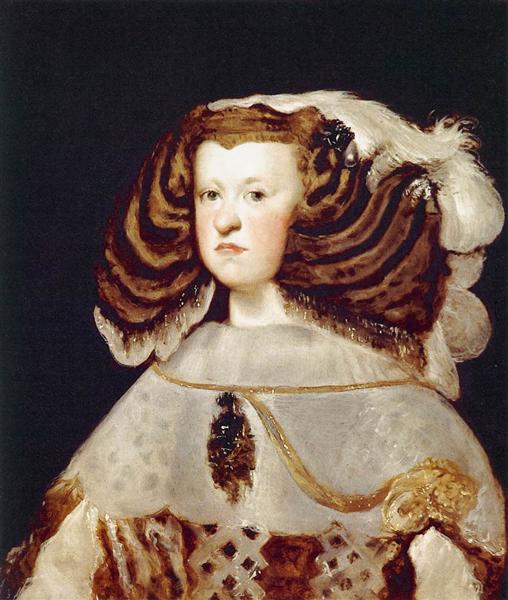説明
At the heart of the 17th century, Diego Velázquez established himself as one of the most masterful voices in Spanish painting, and his 1657 Portrait of Mariana of Austria, Queen of Spain is a striking testament to his ability to capture not only the form but the psychological essence of his subjects. This painting portrays Mariana of Austria, consort of King Philip IV, with an elegance that transcends mere representation and enters the realm of symbolism and royal intimacy.
The painting is characterized by its balanced and harmonious composition, where the figure of the queen occupies a central place, attracting the viewer's attention. Mariana, dressed in a majestic brocade dress, is presented in a pose that exudes dignity and grace. The choice of costume, an elaborate fabric in shades of gold and ivory, reflects not only her status, but also the high level of detail characteristic of Velázquez, who manages to combine textures in such a way that they seem almost palpable. Subtle shadows and lights converge to model the figure of the queen, giving her an air of serenity and power. This mastery of light and shadow is one of the hallmarks of Velázquez's technique, heir to the tenebrist tradition that had been popularized by artists such as Caravaggio.
The background of the work, often neglected in portraits of this kind, becomes a space that complements the central figure rather than distracts from it. With a soft gradient of dark colors that evokes an atmosphere of solemnity, the background allows Mariana's figure to shine with its own luminosity. This choice underlines Velázquez's mastery in creating a context that, although simple, conveys a deep reverence for the subject.
Although the work features no other characters, the queen's presence is enough to fill the space with an aura of regal solemnity. Mariana's face, with an expression that mixes calm and a slight melancholy, invites the viewer to contemplate not only her beauty but also the emotional burden that comes with being a central figure in an empire. Velázquez, through his perceptive gaze, manages to communicate the complexity of life at court, where royalty is often caught between duty and vulnerability.
The art historian has pointed out that this portrait also reflects the influence of the Baroque, a period characterized by its aesthetic rigor and a search for emotional realism. By integrating the technique of contrast between the splendor of the clothing and the sincerity of the expressions, Velázquez blurs the line that often separates portraiture from conceptual art. Such is the case with the portraits of the French court that he had developed at the same time, where the idealized often eclipsed the real. Velázquez chose, instead, to delve deeper into the humanity of his model, a path that distinguishes him from his peers.
The work has survived time and numerous interpretations, appreciated for both its technical prowess and its deep emotional charge. The “Portrait of Mariana of Austria” is a reminder of the crucial role Velázquez played in redefining portraiture in European painting, illuminating the psychology behind representation and instilling an enduring humanity in his subjects. In this sense, the work is not just a portrait of the queen, but a reflection on the sense of identity, power, and the burden she carries with her, leaving an indelible mark on art history.
KUADROS ©, a famous painting on your wall.
Hand-made oil painting reproductions, with the quality of professional artists and the distinctive seal of KUADROS ©.
Painting reproduction service with satisfaction guarantee. If you are not completely satisfied with the replica of your painting, we will refund 100% of your money.

